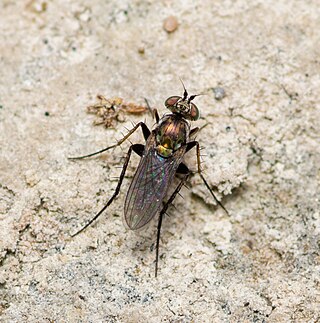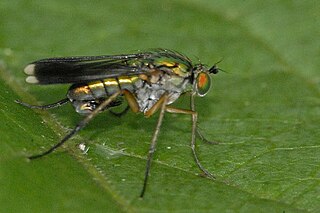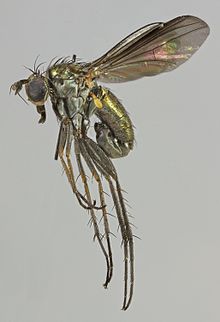
Chrysosoma is a genus of flies in the family Dolichopodidae. It is a large genus, with more than 200 species distributed in the Old World and Oceania.

Lichtwardtia is a genus of flies in the family Dolichopodidae. It is known from the Afrotropical, Oriental and Australasian realms. It can be recognised by its zigzag-shaped M vein on the wings, and its feather-like hairs on the apex segment of the antennae. In a phylogenetic analysis of the subfamily Dolichopodinae by Scott E. Brooks in 2005, Lichtwardtia is considered to be a synonym of Dolichopus, but subsequent authors have retained it as a valid genus.
Nepalomyia is a genus of flies in the family Dolichopodidae.

Paraclius is a genus of flies in the family Dolichopodidae. It is currently considered a polyphyletic assemblage of species.
Pseudohercostomus is a genus of flies in the family Dolichopodidae. It is distributed in the Oriental and Afrotropical realms as well as Chile.

Sybistroma is a genus of flies in the family Dolichopodidae. It includes over 50 species, described mainly from the Palaearctic and Oriental realms. A single species is known from the Afrotropical realm. Until 2005, the genus was thought to be restricted to the Mediterranean in distribution, with five known species. It was recently expanded to include the former genera Hypophyllus, Ludovicius and Nodicornis, as well as some species of Hercostomus.

Tachytrechus is a genus of long-legged flies in the family Dolichopodidae.
Telmaturgus is a genus of flies in the family Dolichopodidae. It has a cosmopolitan distribution.

Dolichopodinae is a subfamily of flies in the family Dolichopodidae.
Ahercostomus is a genus of flies in the family Dolichopodidae. It currently contains only one species, Ahercostomus jiangchenganus, known only from China. Ahercostomus was originally created as a subgenus of Hercostomus; it was later promoted to genus rank by Zhang & Yang (2005). Alternatively, Brook (2005) provisionally regards Ahercostomus as a synonym of Hercostomus.
Aphalacrosoma is a genus of flies in the family Dolichopodidae, known from China and Taiwan.

Peloropeodinae is a subfamily of flies in the family Dolichopodidae. In some classifications, the genera of the subfamily are included in Sympycninae. According to a molecular phylogenetic analysis of the family Dolichopodidae by Germann et al. (2011), the subfamily is polyphyletic.
Allohercostomus is a genus of flies in the family Dolichopodidae. It includes three species from China and Nepal. Members of the genus are metallic green in color and are small in size, with a body length of 2.5–3.2 mm and a wing length of 2.8–3.4 mm. The generic name is a combination of the prefix allo- with the generic name Hercostomus. In Brooks (2005)'s phylogenetic analysis of the subfamily Dolichopodinae, Allohercostomus was hypothesized to be the most basal member of the subfamily based on a triangular depression present on the scutum in front of the scutellum, a plesiomorphy lost in other members of the subfamily. It can also be distinguished from other members of Dolichopodinae by features such as the bottoms of its eyes being contiguous.

Gymnopternus is a genus of flies in the family Dolichopodidae. It was formerly placed as a subgenus of Hercostomus, but is now accepted as a separate genus.
Parahercostomus is a genus of flies in the family Dolichopodidae. It includes four species known only from China. Members of the genus are metallic green in color and large in size, with a body length of 4.5–5.3 mm and a wing length of 5.2–7.0 mm. The generic name is a combination of the prefix para- with the generic name Hercostomus. According to Brooks (2005)'s phylogenetic analysis of the subfamily Dolichopodinae, Parahercostomus appears to be closely related to Grichanov (1999)'s Afrotropical species group 1 in the genus Hercostomus, which was later transferred to the genus Afrohercostomus.

Poecilobothrus is a genus of flies in the family Dolichopodidae.
Pseudargyrochlamys is a genus of flies in the family Dolichopodidae. It was first established by Igor Grichanov in 2006 for four species of Paracleius from eastern South Africa. A fifth species from South Africa was described in 2020. Members of the genus are restricted to the coast of southern Africa between East London in South Africa and Maputo in Mozambique. The genus is closely related to Argyrochlamys and Phoomyia, which are also found in coastal habitats.
Setihercostomus is a genus of flies in the family Dolichopodidae, known from China, Taiwan, Russia and Tanzania.









